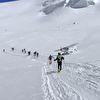Twothousandandfourteen. The new and climbing

 1 / 1
1 / 1 archivio Andrea Tosi
archivio Andrea Tosi
In climbing terms, 2013 finished off badly, the theme of "safety" came to fore accompanied by all the drama possible. The veiled attempts to "gently" teach "how-to-belay-your-partner-properly" seem not to have produced the desired results. And while the veiled Goddess of Fortune, who truly loves us, clasps her hands over her eyes to avoid watching how we belay, we continue to imitate here, the only difference being that to avoid seeing, we stick our heads into the ground like an ostrich. In this evolutionary spiral that climbing is currently experiencing, perhaps we are losing sight of its origin and therefore the mainstay of our sport, namely the fact the actions can be repeated and, as such, the chance to improve by trying, and trying again.
In my view two roads lead to this result. The first is a return to the potential pain that can be experienced by a climbing partnership, intended as a leader and the belayer. One needs to bear in mind the risk of physical harm inflicted on the leader and the psychological risk inflicted on who belays poorly. I don't want to point my finger at someone's ability to belay properly. No, anyone can make a mistake. What is important though is to reduce to an absolute minimum the ability to make errors, via tried-and-tested belay techniques (manufacturers provide precise, though almost always ignored, instructions about how to use the brakes) and by bearing in mind that in certain particularly "sporty" situations it may be worth controlling your desire to watch out for 5 minutes instead of checking the pump in your forearms. We could discuss this at great length and perhaps we will do so in the future, with some in-depth analysis with more material (videos, too), but the indoor accident statistics speak for themselves.
The second option is to make everything we already have safe, this craze to create "new routes", "new crags" is rendering many existing areas orphans. What we're experiencing is a continuous "giving birth", but who will then take care of it all? Perhaps elsewhere (read Africa) the community would look after them, but here this concept does not exist. As is clear for all to see. Routes have a life expectancy that is longer that the first ascentionists and if you start to neglect a crag... well sooner or later Nature first reclaims the holds, then the anchors. It's only a matter of time.
Having said that, there is a positive note. It didn't make headline news because it couldn't be "branded" with the magic word "new", but in truth it should have been "The News", more so than any new route... I'm talking about the rebolting, the replacement of a particularly poor bolt, and many others that had started down the same road towards unreliability. The route in question is the classic line at Castel Presina: "Baby Doc", rebolted by Andrea Simonini and Giacomo Duzzi who, apart from creating new routes, also have enough common sense to fix things that perhaps many others had seen, but not bothered about.
I think the time has come to stop glorifying the new, and an act like this one, like rebolting old crags or routes, is a step forward towards this sport's maturity. Safeguarding the old gives more importance to the new as it removes that hint of consumerism that often accompanies routes which have nothing new to them and which, often, were not even needed. To be truly "new", something must bring with it a novelty, otherwise it merely becomes an act of owning / marking the rock that, sooner or later, is destined to run out. The time is ripe to assess whether it's worth pressing on the new routing accelerator.
Initially climbers bolted new routes for the beauty of the line or to add something more difficult, adding something to 9b+ is a tough task and decidedly elitist, so it's now worth thinking about what we're really adding as we fill crags to the brim or establish new areas that add nothing new to the numerous existing routes. If all goes well, the only thing that is obvious is the neglect that the older crags will fall into.
The rise in popularity of great classics means that visiting climbers who travel great distances to climb them are exposed to potential risks as they have no way of knowing about the state of a particular route. Perhaps they come after having gleamed information from popular sites, where it's easy to get info about the "performability" of this or that route, but when they get there they often lack the ability to check the state of the in-situ gear... as it is, routes sometimes become classics for the most obscure reasons, while the reason why a bolt rusts are very obvious.
More and more anchors go "snap" when solicited while being replaced, and this does effect the psyche somewhat... To avoid making mistakes I use brakes, I expressly want to terrorise people, fire into the air to see if someone gets scared and begins to think that maybe... this could happen to him or her, too, that it's worthwhile becoming aware of what's going on, and that you're not OK simply because you only climb at the weekends.
Today I'm certainly wrong, but time is on my side, it's just about anticipating the negative effects that distraction could have on our bodies or minds. Having said that, have a great 2014, but please, let's not talk about the "new" year, let's bear in mind where we come from and let's try to make sure that the "past" doesn't return to haunt us, physically or psychologically.
Andrea Tosi
http://kingboulderblog.blogspot.it
www.kingrock.it
Semina del tassello from Mountain View on Vimeo.



 Copia link
Copia link























